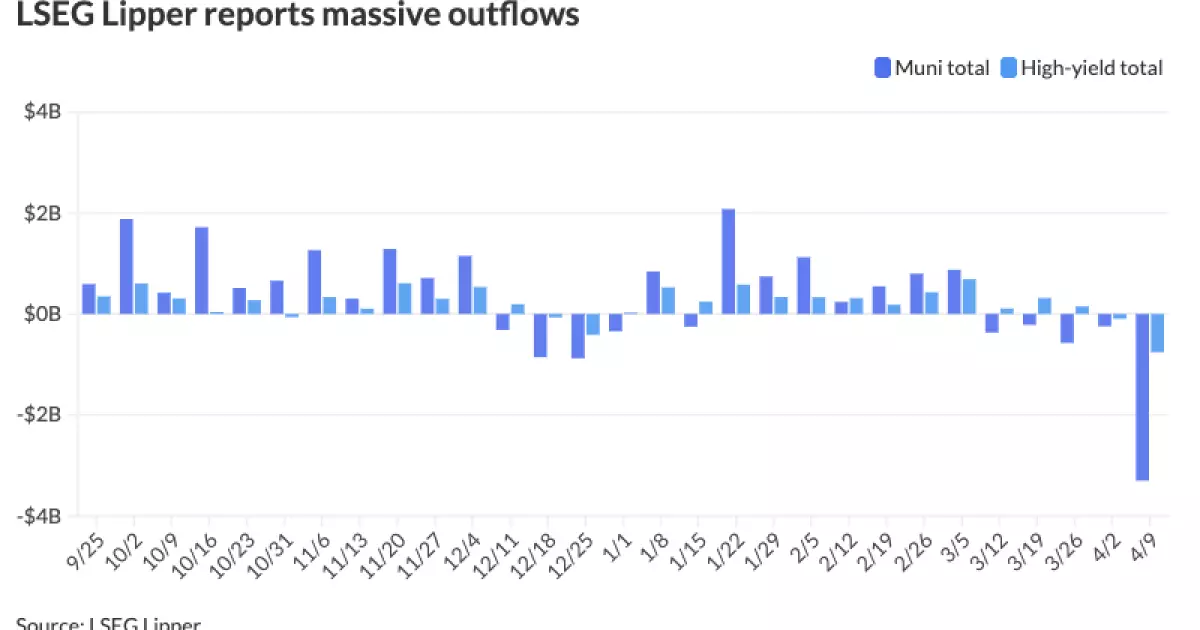The municipal bond market has always been a reflection of broader economic sentiment, but recent developments indicate a particularly tumultuous phase. Last Thursday, municipal bonds rallied, gaining back losses that stemmed from earlier in the week amid escalating tensions between the U.S. and China and a remarkable inflation report. A closer analysis reveals a mixed outlook for the market, with several underlying factors contributing to its volatility. The recent $3.3 billion outflow from municipal bond mutual funds, the largest since June 2022, signals not just investor apprehension but also a shift in sentiment that investors must navigate carefully.
The price movements highlighted by analysts such as Michael Pietronico and Mark Paris showcase just how unpredictable this market can be. While one could argue that the rally is an indication of confidence, the reality is far more concerning. The underlying factors pushing yields up and down indicate a precarious balancing act, with municipal bond investors facing potential pitfalls at every turn. Bond yields fluctuating between -26 to -54 basis points on AAA scales exemplify this volatility, and if recent trends are any indication, investors may be entering a storm rather than weathering a passing shower.
The Tariff Effect: An Ongoing Concern
The recent announcement of a 90-day tariff extension was seen as a temporary relief, but the underlying tension remains palpable. Analysts continue to warn that tariffs will continue to create ripples in the bond market. The volatility surrounding these tariffs isn’t simply a matter of short-term fluctuations; it is indicative of a broader uncertainty stemming from unpredictable economic policies. If recent market reactions to policy announcements are any indication, the next few months promise to be filled with uncertainty as investors grapple with long-term implications rather than short-term impacts.
Both Michael Pietronico and Tom Murphy emphasize that this tumult will remain a key factor influencing performance in municipal bonds over the coming months. A spike in volatility, despite the current pause in negotiations and policy changes, could thrust investors into a precarious position. The potential for a “yield shock” looms large, and those unprepared for the possibility of sudden shifts may find themselves at great risk. A short-term pause of such tariffs may seem beneficial, but the potential fallout should not be underestimated.
Investor Sentiment and Economic Indicators
The market’s response to the consumer price index (CPI) report indicating a year-over-year inflation rise of 2.4% — lower than the expected 2.6% — provides a fleeting semblance of stability. While the report was initially interpreted positively, it leaves the door open for skepticism, particularly amidst continued uncertainty. The municipal bond market is gaining some momentum, but it remains vulnerable to quickly changing economic indicators and geopolitical dynamics. The current outflows combined with a lack of inflow momentum suggest that investor confidence is waning.
Given historical patterns, the market may experience further downturns despite the fleeting positives. As Tom Murphy pointed out, there was already a tapering in demand amongst investors even before these heightened conditions reared their head, a signal that investor patience may be wearing thin. With municipalities seeing outflows for five consecutive weeks, one has to question whether this is just a momentary blip or if it signifies a deeper malaise in the municipal investment landscape.
Market Dynamics: A Cautious Path Ahead
What we’re observing is the manifestation of multiple headwinds — high supply, ongoing tariff discussions, and fluctuating credit quality — feeding into a complicated bond market environment. With the SIFMA Swap Index shooting up to 4.41%, past precedents indicate that the road ahead will be bumpy for those investing in long-term municipal bonds. Moreover, as Rick White notes, the increase in inventories combined with varying interest rates indicates a market grappling with itself, trying to strike a balance that is elusive at best.
Therefore, while municipal bonds may present opportunities for gains, the risks now outweigh the rewards. The interplay between supply and demand coupled with a looming tariff debate creates a minefield that could adversely impact yields in unexpected ways. Institutions that habitually relied on the predictability of municipal bonds as a low-risk investment must now come to terms with a new reality: this sector is no longer the safe haven it once promised to be.
The landscape for municipal bonds is shifting underfoot, revealing no shortage of challenges. As investors navigate the tumult of the current market, one must approach with vigilance, as the forthcoming months will surely test the mettle of seasoned investors and newcomers alike. The tension is palpable, and with so much at stake, we should brace ourselves for a thrilling, yet potentially hazardous, ride ahead.

